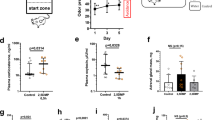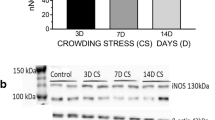Abstract
Rationale and objective
The presence of three conspecifics prevents stress-induced decreases in newly proliferated cells and neuroblasts in mouse dentate gyrus (DG). In this study, we sought to determine how many conspecifics are required to exert these protective effects against stress. In addition, we manipulated the physiological status of those conspecifics in the context of their stress-buffering effects and used airborne oxytocin exposure as a substitute for the presence of conspecifics.
Materials and methods
Bromodeoxyuridine staining was used to indicate the newly proliferated cells and co-staining with doublecortin to reveal the proliferative neuroblasts.
Results
Presentation of three intact and lipopolysaccharide-treated conspecifics prevented the stress-induced decreases in the number of newly proliferated cells and neuroblasts in DG. Presentation of one saline- or oxytocin (OT)–treated conspecific did not exert observable stress-buffering effects. In contrast, airborne oxytocin prevented the stress-induced decreases in DG cell proliferation and early neurogenesis, while pretreatment with L-371,257, a selective OT receptor antagonist, abolished the buffering effects of OT.
Conclusions
Physical interaction with the conspecifics and conspecifics’ sickness, at best, play a minor role in mediating the buffering effects against stress-induced decreases in DG cell proliferation or early neurogenesis. Moreover, stress-buffering effects are negligible with the presence of only one conspecific. Finally, airborne OT produced stress-buffering effects possibly via its stimulation of OT receptors. Oxytocin merits further study as a substitute for the stress-buffering effects of companions.





Similar content being viewed by others
References
Adan RA, Van Leeuwen FW, Sonnemans MA, Brouns M, Hoffman G, Verbalis JG, Burbach JP (1995) Rat oxytocin receptor in brain, pituitary, mammary gland, and uterus: partial sequence and immunocytochemical localization. Endocrinol 136:4022–4028
Antonson AM, Radlowski EC, Lawson MA, Rytych JL, Johnson RW (2017) Maternal viral infection during pregnancy elicits anti-social behavior in neonatal piglet offspring independent of postnatal microglial cell activation. Brain Behav Immun 59:300–312
Baker JD, Ozsan I, Rodriguez Ospina S, Gulick D, Blair LJ (2018) Hsp90 heterocomplexes regulate steroid hormone receptors: from stress response to psychiatric disease. Int J Mol Sci 20:E79
Bartekova M, Barancik M, Pokusa M, Prokopova B, Radosinska J, Rusnak A, Breier A, Jezova D (2015) Molecular changes induced by repeated restraint stress in the heart: the effect of oxytocin receptor antagonist atosiban. Can J Physiol Pharmacol 93:827–834
Bragin AV, Osadchuk LV, Osadchuk AV (2007) Competition for limited environmental resources on the social dominance model in laboratory mice. Zh Vyssh Nerv Deiat Im I P Pavlova 57:358–365
Cameron HA, McKay RD (1999) Restoring production of hippocampal neurons in old age. Nat Neurosci 2:894–897
Cherng CG, Lin PS, Chuang JY, Chang WT, Lee YS, Kao GS, Lai YT, Yu L (2010) Presence of conspecifics and their odor-impregnated objects reverse stress-decreased proliferated neuroblasts in mouse dentate gyrus. J Neurochem 112:1138–1146
Cherng CF, Chang CP, Su CC, Tzeng WY, Chuang JY, Chen LH, Lin KY, Yu L (2012) Odors from proximal species reverse the stress-decreased proliferated neuroblasts via main olfactory processing. Behav Brain Res 229:106–112
Choe HK, Reed MD, Benavidez N, Montgomery D, Soares N, Yim YS, Choi GB (2015) Oxytocin mediates entrainment of sensory stimuli to social cues of opposing valence. Neuron 87:152–163
Cohn DW, Gabanyi I, Kinoshita D, de Sa-Rocha LC (2012) Lipopolysaccharide administration in the dominant mouse destabilizes social hierarchy. Behav Process 91:54–60
Ermisch A, Barth T, Rühle HJ, Skopková J, Hrbas P, Landgraf R (1985) On the blood-brain barrier to peptides: accumulation of labelled vasopressin, DesGlyNH2-vasopressin and oxytocin by brain regions. Endocrinol Exp 19:29–37
Fernando D, Siederer S, Singh S, Schneider I, Gupta A, Powell M, Richards D, McIntosh MP, Lambert P, Fowles S (2017) Safety, tolerability and pharmacokinetics of single doses of oxytocin administered via an inhaled route in healthy females: randomized, single-blind, phase 1 study. EBioMedicine 22:249–255
Fish EW, DeBold JF, Miczek KA (2005) Escalated aggression as a reward: corticosterone and GABA(A) receptor positive modulators in mice. Psychopharmacology 182:116–127
Fritz M, Rawas RE, Salti A, Klement S, Bardo MT, Kemmler G, Dechant G, Saria A, Zernig G (2011) Reversal of cocaine-conditioned place preference and mesocorticolimbic Zif268 expression by social interaction in rats. Addict Biol 16:273–284
Gordon I, Zagoory-Sharon O, Leckman JF, Feldman R (2010) Oxytocin, cortisol, and triadic family interactions. Physiol Behav 101:679–684
Gravati M, Busnelli M, Bulgheroni E, Reversi A, Spaiardi P, Parenti M, Toselli M, Chini B (2010) Dual modulation of inward rectifier potassium currents in olfactory neuronal cells by promiscuous G protein coupling of the oxytocin receptor. J Neurochem 114:1424–1435
Hilakivi-Clarke L, Lister RG (1992) Social status and voluntary alcohol consumption in mice: interaction with stress. Psychopharmacology 108:276–282
Kazlauskas N, Klappenbach M, Depino AM, Locatelli FF (2016) Sickness behavior in honey bees. Front Physiol 7:261
Kirsten TB, Taricano M, Flório JC, Palermo-Neto J, Bernardi MM (2010a) Prenatal lipopolysaccharide reduces motor activity after an immune challenge in adult male offspring. Behav Brain Res 211:77–82
Kirsten TB, Taricano M, Maiorka PC, Palermo-Neto J, Bernardi MM (2010b) Prenatal lipopolysaccharide reduces social behavior in male offspring. Neuroimmunomodulation 17:240–251
Kojima S, Stewart RA, Demas GE, Alberts JR (2012) Maternal contact differentially modulates central and peripheral oxytocin in rat pups during a brief regime of mother-pup interaction that induces a filial huddling preference. J Neuroendocrinol 24:831–840
Liu JC, Guastella AJ, Dadds MR (2012) Effects of oxytocin on human social approach measured using intimacy equilibriums. Horm Behav 62:585–591
Mattson MP, Duan W, Wan R, Guo Z (2004) Prophylactic activation of neuroprotective stressor response pathways by dietary and behavioral manipulations. NeuroRx 1:111–116
Maynard KR, Hobbs JW, Phan BN, Gupta A, Rajpurohit S, Williams C, Rajpurohit A, Shin JH, Jaffe AE, Martinowich K (2018) BDNF-TrkB signaling in oxytocin neurons contributes to maternal behavior. Elife 7:e33676
Meyer M, Gonzalez Deniselle MC, Hunt H, de Kloet ER, De Nicola AF (2014) The selective glucocorticoid receptor modulator CORT108297 restores faulty hippocampal parameters in Wobbler and corticosterone-treated mice. J Steroid Biochem Mol Biol 143:40–48
Mirescu C, Gould E (2006) Stress and adult proliferated neuroblasts. Hippocampus 16:233–238
Nath C, Gulati A, Dhawan KN, Gupta GP, Bhargava KP (1982) Evidence for central histaminergic mechanism in foot shock aggression. Psychopharmacology 76:228–231
Oettl LL, Ravi N, Schneider M, Scheller MF, Schneider P, Mitre M, da Silva GM, Froemke RC, Chao MV, Young WS, Meyer-Lindenberg A, Grinevich V, Shusterman R, Kelsch W (2016) Oxytocin enhances social recognition by modulating cortical control of early olfactory processing. Neuron 90:609–621
Pawluski JL, Brummelte S, Barha CK, Crozier TM, Galea (2009) LA effects of steroid hormones on proliferated neuroblasts in the hippocampus of the adult female rodent during the estrous cycle, pregnancy, lactation and aging. Front Neuroendocrinol 30:343–357
Peartree NA, Hood LE, Thiel KJ, Sanabria F, Pentkowski NS, Chandler KN, Neisewander JL (2012) Limited physical contact through a mesh barrier is sufficient for social reward-conditioned place preference in adolescent male rats. Physiol Behav 105:749–756
Rolinski Z, Herbut M (1981) The role of the serotonergic system in foot shock-induced behavior in mice. Psychopharmacology 73:246–251
Sairanen M, Lucas G, Ernfors P, Castren M, Castren E (2005) Brain-derived neurotrophic factor and antidepressant drugs have different but coordinated effects on neuronal turnover, proliferation, and survival in the adult dentate gyrus. J Neurosci 25:1089–1094
Schramm-Sapyta NL, Pratt AR, Winder DG (2004) Effects of periadolescent versus adult cocaine exposure on cocaine conditioned place preference and motor sensitization in mice. Psychopharmacology 173:41–48
Smith AS, Wang Z (2014) Hypothalamic oxytocin mediates social buffering of the stress response. Biol Psychiatry 76:281–288
Tanapat P, Hastings NB, Rydel TA, Galea LA, Gould E (2001) Exposure to fox odor inhibits cell proliferation in the hippocampus of adult rats via an adrenal hormone-dependent mechanism. J Comp Neurol 437:496–504
Thiel KJ, Okun AC, Neisewander JL (2008) Social reward-conditioned place preference: a model revealing an interaction between cocaine and social context rewards in rats. Drug Alcohol Depend 96:202–212
Thiel KJ, Sanabria F, Neisewander JL (2009) Synergistic interaction between nicotine and social rewards in adolescent male rats. Psychopharmacology 204:391–402
Tzeng WY, Chuang JY, Lin LC, Cherng CG, Lin KY, Chen LH, Su CC, Yu L (2013) Companions reverse stressor-induced decreases in proliferated neuroblasts and cocaine conditioning possibly by restoring BDNF and NGF levels in dentate gyrus. Psychoneuroendocrinology 38:425–437
Tzeng WY, Chen LH, Cherng CG, Tsai YN, Yu L (2014) Sex differences and the modulating effects of gonadal hormones on basal and the stressor-decreased newly proliferative cells and neuroblasts in dentate gyrus. Psychoneuroendocrinology 42:24–37
Tzeng WY, Cherng CF, Wang SW, Yu L (2016) Familiar companions diminish cocaine conditioning and attenuate cocaine-stimulated dopamine release in the nucleus accumbens. Behav Brain Res 306:146–153
Tzeng WY, Cherng CG, Yu L, Wang CY (2017a) Basolateral amygdalar D2 receptor activation is required for the companions-exerted suppressive effect on the cocaine conditioning. Neurobiol Learn Mem 137:48–55
Tzeng WY, Wu HH, Wang CY, Chen JC, Yu L, Cherng CG (2017b) Sex differences in stress and group housing effects on the number of newly proliferated cells and neuroblasts in middle-aged dentate gyrus. Front Behav Neurosci 10:249
Tzeng WY, Huang TY, Cherng CG, Yang SN, Yu L (2017c) Social buffering prevents stress-induced decreases in dendritic length, branching in dentate granule cells and hippocampus-related memory performance. Neuropsychiatry (London) 7:640–652
Wagner GC, Carelli RM (1987) Effects of fluprazine (DU27716) and ethanol on target biting behavior and intruder-evoked attacks. Psychopharmacology 91:193–197
Watanabe S (2011) Drug-social interactions in the reinforcing property of methamphetamine in mice. Behav Pharmacol 22:203–206
Watanabe S (2013) Social factors in conditioned place preference with morphine in mice. Pharmacol Biochem Behav 103:440–443
Williams PD, Clineschmidt BV, Erb JM, Freidinger RM, Guidotti MT, Lis EV, Pawluczyk JM, Pettibone DJ, Reiss DR, Veber DF (1995) 1-(1-4-(N-acetyl-4-piperidinyl)oxy-2-methoxybenzoylpiperidin-4- yl)-4H-3,1-benzoxazin-2(1H)-one (L-371,257): a new, orally bioavailable, non-peptide oxytocin antagonist. J Med Chem 38:4634–4636
Witt DM, Winslow JT, Insel TR (1992) Enhanced social interactions in rats following chronic, centrally infused oxytocin. Pharmacol Biochem Behav 43:855–861
Xuan IC, Hampson DR (2014) Gender-dependent effects of maternal immune activation on the behavior of mouse offspring. PLoS One 9:e104433.25
Yang ZF, Ho DW, Lau CK, Tam KH, Lam CT, Poon RT, Fan ST (2006) Platelet activation during tumor development, the potential role of BDNF-TrkB autocrine loop. Biochem Biophys Res Commun 346:981–985
Yee JR, Prendergast BJ (2012) Endotoxin elicits ambivalent social behaviors. Psychoneuroendocrinology 37:1101–1105
Acknowledgments
We would like to extend our deepest appreciation for Prof. G.C. Wagner’s reading and proofing of the manuscript.
Funding
This research was supported by ROC Ministry of Science and Technology (MOST) grants 103-2410-H-006-028-MY3 to L.Y., and 107-2629-H-010-002 to C.G.C.
Author information
Authors and Affiliations
Contributions
L-H.S., W-Y.T., Y-H.L., C.G.C., and L.Y. were involved in manuscript writing and editing and collecting most of the data. L-H.S., W-Y.T., Y-H.L., C.G.C., and L.Y. came up with the experiment proposal and contributed to the experimental designs. C.G.C. contributed to most data analysis. W-T.D. was responsible for a part of data collection, data analysis, and interpretation.
Corresponding authors
Ethics declarations
Conflict of interest
The authors declare that they have no conflict of interest.
Additional information
Publisher’s note
Springer Nature remains neutral with regard to jurisdictional claims in published maps and institutional affiliations.
Rights and permissions
About this article
Cite this article
Sun, LH., Tzeng, WY., Liao, YH. et al. Relevance of number and physiological status of conspecifics in preventing stress-induced decreases in newly proliferated cells and neuroblasts. Psychopharmacology 236, 3329–3339 (2019). https://doi.org/10.1007/s00213-019-05290-4
Received:
Accepted:
Published:
Issue Date:
DOI: https://doi.org/10.1007/s00213-019-05290-4




